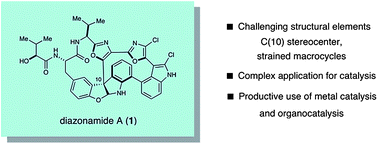This month sees the following articles in Chemical Science that are in the top ten most accessed:-
Ir-catalyzed highly selective addition of pyridyl C-H bonds to aldehydes promoted by triethylsilane
Bi-Jie Li and Zhang-Jie Shi
Chem. Sci., 2011, Advance Article, DOI: 10.1039/C0SC00419G, Edge Article
Dialkylbiaryl phosphines in Pd-catalyzed amination: a user’s guide
David S. Surry and Stephen L. Buchwald
Chem. Sci., 2011, 2, 27-50, DOI: 10.1039/C0SC00331J, Perspective
Diamine ligands in copper-catalyzed reactions
David S. Surry and Stephen L. Buchwald
Chem. Sci., 2010, 1, 13-31, DOI: 10.1039/C0SC00107D, Perspective
Azomethine ylide annulations: facile access to polycyclic ring systems
Chen Zhang, Deepankar Das and Daniel Seidel
Chem. Sci., 2011, Advance Article, DOI: 10.1039/C0SC00432D, Edge Article
Amine directed Pd(ii)-catalyzed C-H bond functionalization under ambient conditions
Benjamin Haffemayer, Moises Gulias and Matthew J. Gaunt
Chem. Sci., 2011, Advance Article, DOI: 10.1039/C0SC00367K, Edge Article
Synthesis and carbene-transfer reactivity of dimeric nickel carbene cations supported by N-heterocyclic carbene ligands
Carl A. Laskowski and Gregory L. Hillhouse
Chem. Sci., 2011, Advance Article, DOI: 10.1039/C0SC00464B, Edge Article
Metallacycle-mediated cross-coupling with substituted and electronically unactivated alkenes
Holly A. Reichard and Glenn C. Micalizio
Chem. Sci., 2011, Advance Article, DOI: 10.1039/C0SC00394H, Perspective
Palladium-catalyzed coupling of functionalized primary and secondary amines with aryl and heteroaryl halides: two ligands suffice in most cases
Debabrata Maiti, Brett P. Fors, Jaclyn L. Henderson, Yoshinori Nakamura and Stephen L. Buchwald
Chem. Sci., 2011, 2, 57-68, DOI: 10.1039/C0SC00330A, Edge Article
Total synthesis of all (-)-agelastatin alkaloids
Mohammad Movassaghi, Dustin S. Siegel and Sunkyu Han
Chem. Sci., 2010, 1, 561-566 DOI: 10.1039/C0SC00351D, Edge Article
Continuous flow multi-step organic synthesis
Damien Webb and Timothy F. Jamison
Chem. Sci., 2010, 1, 675-680, DOI: 10.1039/C0SC00381F, Minireview
Why not take a look at the articles today and blog your thoughts and comments below.
Fancy submitting an article to Chemical Science? Then why not submit to us today or alternatively email us your suggestions.













